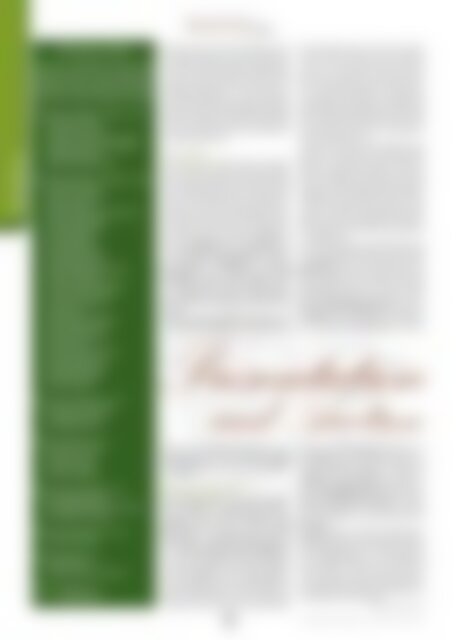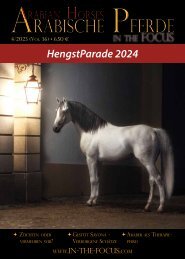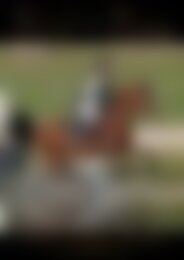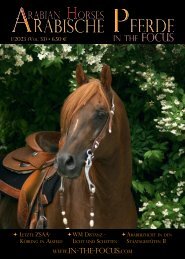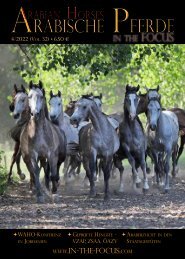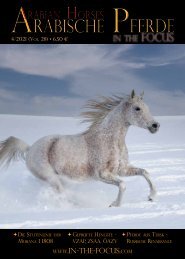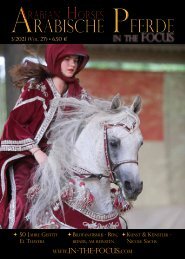Arabische Pferde IN THE FOCUS Nr. 2/2019 - Preview
Zeitschrift für Liebhaber arabischer Pferde
Zeitschrift für Liebhaber arabischer Pferde
Sie wollen auch ein ePaper? Erhöhen Sie die Reichweite Ihrer Titel.
YUMPU macht aus Druck-PDFs automatisch weboptimierte ePaper, die Google liebt.
Breeding<br />
The Strains in Syria<br />
At present, the following strains are still<br />
maintained within Syria (in brackets the<br />
European common names). The numbers<br />
behind the strain name indicate the number<br />
of horses in Syria of that strain in 2016.<br />
Al Saglawiat (Siglawy / Saklawi) - 2907<br />
Saglawiet Ibn Bisra<br />
Saglawieh Jedranieh<br />
Saglawieh Jedranieh Ibn Zobeini<br />
Saglawieh Jedranie Ibn Amoud<br />
Saglawieh Shaifieh<br />
Saglawieh Marzakanieh<br />
Al Keheilat (Koheilan / Kuhaylan) - 1488<br />
Keheilet Ibn Mizher<br />
Keheilet Um Arqoub<br />
Keheilet Jreibeh<br />
Keheilet Jalfat Sattam Al Boulad<br />
Keheilet Jalfet Dahwi<br />
Keheileh Hablanieh<br />
Kheieleh Haifieh<br />
Keheileh Khidlieh<br />
Keheileh Khalawieh<br />
Keheileh Da'ajanieh<br />
Keheileh DaÄajanieh Kasher<br />
Keheilet Al Rabdah<br />
Keheilet Reeshah Sarabieh<br />
Keheilet Sa'adat Touqan<br />
Keheilet Al Tewaiseh<br />
Keheilet Ajuz<br />
Keheilet Ajuz Ibn Jleidan<br />
Keheileh Armousheh<br />
Keheilet Al Kubeysha<br />
Keheilet Krush<br />
Keheilet Krush Al Abaida<br />
Keheilet Al Musineh<br />
Keheileh Memrahieh<br />
Keheileh Nawakieh<br />
Keheilet Al Wati<br />
Al Hamdaniat (Hamdani) - 560<br />
Hamdaniat Ibn Ghorab<br />
Hamdanieh Semrieh<br />
Hamdanieh Al Efri<br />
target accuracy in archery. The archers were no<br />
less than Ali Goorchian, President of the Persian<br />
Horseback Archery Association, World Champion<br />
in 2011 and 2012, and Bronze medalist 2016,<br />
as well as Ana Sokolska, also one of the world's<br />
leading horseback archers. She has been successfully<br />
participating in many international<br />
events and has a training stable for horseback<br />
archery in Poland. And finally Walid Khawajkye<br />
of Syrian nationality, but living in Qatar. None<br />
of them missed the target as one might expect<br />
in this high-profile cast.<br />
for the European buyers, who did not need to<br />
take all the risks involved in such an expedition,<br />
but, on the other hand, these horses had<br />
their price. For example, the German-Austrian<br />
Baron von Fechtig was one of the first Europeans<br />
to make the importation of Arabian horses<br />
a business model. When he imported the<br />
stallions Bairaktar and Tajar for the Royal Stud<br />
Weil of the King of Württemberg, he asked the<br />
price of 4500 Imperial Ducats for them. Today,<br />
the gold value of these coins is equivalent to<br />
around half a Million Euro!<br />
Of course, the prices are very different today.<br />
The Director of the Arabian Horse Office at the<br />
Ministry of Agriculture, Engineer Mohamed<br />
Ghyath al-Shayeb, estimated the value of exports<br />
to the Gulf States in 2006, 2007, and 2008<br />
to be around 40 to 50 million Syrian pounds (ca.<br />
600.000 €), some individual horses were sold for<br />
75.000 € and more. The prices today are in the<br />
range of 10-15.000 € for a quality horse and this<br />
decline makes horse keeping and breeding difficult<br />
because food and medicine are expensive<br />
- if available at all.<br />
The economic embargo, imposed by the US and<br />
EU on Syria, makes the situation for the people<br />
even worse, of course. We saw queues of cars,<br />
several kilometers long, waiting for fuel at the<br />
one gas station that was supplied with some<br />
gasoline. The tourism sector, once accounting<br />
for 14% of the GDP of Syria, has been crushed,<br />
and as long as the foreign embassies are not reopening,<br />
tourism won't come back, despite the<br />
fact that there are safe areas, such as Damascus.<br />
The Syrian people are longing for tourists<br />
and Auction<br />
Al Obayat (Obayan) - 498<br />
Obayet Ibn Sehayan<br />
Obayet Um Jreis<br />
Obeyah Seheilieh<br />
Obeyah Sharakieh<br />
Al Ma'anagiat (Maanaghi) - 416<br />
Ma'anagieh Sbeylieh<br />
Ma'anagieh Sbeiliet Abou Saifain<br />
Ma'anagieh Hadraouji<br />
Al Shweimat (Shuwaiman) - 269<br />
Shweimat Sabbah<br />
Al Hedeb (Hadban) - 42<br />
Hadban Enzahi<br />
Hadban Enzahi Al Fawaarah<br />
Al Dahmat (Dahman) - 9<br />
Dahmah Amir<br />
The Strains<br />
There has been scientific research conducted<br />
on the genetic diversity of the Syrian Arabian<br />
horse, which confirmed that the Syrian Arabian<br />
has the biggest diversity of all. That does make<br />
sense, if you imagine, that our purchasing commissions<br />
in the 19th century only selected relatively<br />
few specimens out of a huge gene (or horse)<br />
pool, most of which were of the same "type"<br />
or preference, most of them represented only a<br />
few strains, as they were often purchased from<br />
the same Bedouin tribes, the Anazeh with their<br />
sub-tribes F'daan, S'baa, Ruallah, etc. From this<br />
nucleus, which represented only a fraction of<br />
what was there, the Arabian horse was bred<br />
on in the West, often by inbreeding, because of<br />
the limited number of horses available. So, genetic<br />
diversity wasn't big in the beginning and<br />
decreased due to inbreeding in the West even<br />
further.<br />
Presentation<br />
But the greater the genetic diversity, the more<br />
"original" is the population. The genetic diversity<br />
of the autochthonous (indigenous) Arabian<br />
horse populations of Syria and Iran is bigger<br />
than anywhere else in the world. This makes it<br />
so unique!<br />
Economic Problems<br />
After the Napoleonic wars, when horse breeding<br />
in Europe was devastated, some Europeans<br />
started to make the importation of<br />
Arabian horses from Syria a "business model".<br />
These horses were meant to bring the still<br />
existing, but in numbers and quality greatly<br />
decimated breeding stock in Europe back<br />
on track. The "business model" included the<br />
necessary expertise about horses in general<br />
and the Arabian horse in particular, taking the<br />
risk to go to Arabia and its adjacent areas to<br />
purchase suitable horses, and bring them safe<br />
and sound to Europe, mainly to the ports of<br />
Trieste or Livorno. This was an ideal solution<br />
to come back - and one little story shall serve as<br />
an example: It was a cold and miserable day - it<br />
was actually snowing! -, when we visited some<br />
temples and the amphitheater in Shahba, in<br />
the province of Daraa. We were freezing as nobody<br />
was dressed appropriately for the cold weather<br />
when suddenly a local resident came and<br />
offered us some tea. He had seen us, the first<br />
tourists for many years, and heartily welcomed<br />
us his way.<br />
The Arabian horse is a symbol of originality, friendship,<br />
and loyalty. It brings people together<br />
from around the world and creates a basis for<br />
mutual understanding as can be experienced<br />
at every WAHO Conference. But especially the<br />
2007 conference in Syria, at the very source of<br />
our breed, demonstrated that despite all political<br />
agendas, those who love the Arabian horse<br />
cannot hate Syria and its people.<br />
Gudrun Waiditschka<br />
16<br />
© ARABISCHE PFERDE - <strong>IN</strong> <strong>THE</strong> <strong>FOCUS</strong> 2/<strong>2019</strong>


